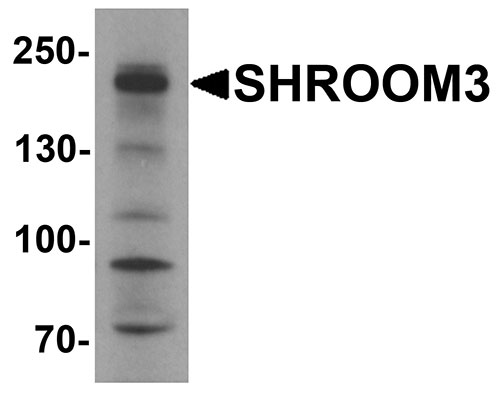SHROOM3 Antibody
- SPECIFICATION
- CITATIONS
- PROTOCOLS
- BACKGROUND

Application
| WB, E |
|---|---|
| Primary Accession | Q8TF72 |
| Other Accession | NP_065910, 203098098 |
| Reactivity | Human |
| Host | Rabbit |
| Clonality | Polyclonal |
| Isotype | IgG |
| Calculated MW | 220 kDa |
| Application Notes | SHROOM3 antibody can be used for detection of SHROOM3 by Western blot at 1 - 2 µg/mL. |
| Gene ID | 57619 |
|---|---|
| Target/Specificity | SHROOM3; SHROOM3 antibody is human specific. At least four isoforms of SHROOM3 are known to exist; this antibody will detect all four isoforms. SHROOM3 antibody is predicted to not cross-react with other SHROOM family members. |
| Reconstitution & Storage | SHROOM3 antibody can be stored at 4℃ for three months and -20℃, stable for up to one year. As with all antibodies care should be taken to avoid repeated freeze thaw cycles. Antibodies should not be exposed to prolonged high temperatures. |
| Precautions | SHROOM3 Antibody is for research use only and not for use in diagnostic or therapeutic procedures. |
| Name | SHROOM3 |
|---|---|
| Synonyms | KIAA1481, SHRML |
| Function | Controls cell shape changes in the neuroepithelium during neural tube closure. Induces apical constriction in epithelial cells by promoting the apical accumulation of F-actin and myosin II, and probably by bundling stress fibers (By similarity). Induces apicobasal cell elongation by redistributing gamma-tubulin and directing the assembly of robust apicobasal microtubule arrays (By similarity). |
| Cellular Location | Cell junction, adherens junction {ECO:0000250|UniProtKB:Q9QXN0}. Cytoplasm, cytoskeleton {ECO:0000250|UniProtKB:Q9QXN0}. Apical cell membrane {ECO:0000250|UniProtKB:Q9QXN0}; Peripheral membrane protein {ECO:0000250|UniProtKB:Q9QXN0}. Note=Colocalizes with F-actin in stress fibers and adherens junctions. {ECO:0000250|UniProtKB:Q9QXN0} |

Thousands of laboratories across the world have published research that depended on the performance of antibodies from Abcepta to advance their research. Check out links to articles that cite our products in major peer-reviewed journals, organized by research category.
info@abcepta.com, and receive a free "I Love Antibodies" mug.
Provided below are standard protocols that you may find useful for product applications.
Background
SHROOM3 Antibody: SHROOM family members play diverse roles in the development of the nervous system and other tissues. SHROOM3 is an actin-binding protein is a regulator of the microtubule cytoskeleton during epithelial morphogenesis and is sufficient and necessary to induce a redistribution of the microtubule regulator gamma-tubulin. It is necessary for both apiscobasal cell elongation and apical constriction in the neural epithelium. SHROOM3 has also been shown to be essential for cell shape changes and morphogenesis in the developing vertebrate gut, with its transcription relying on the Pitx1 transcription factor.
References
Lee C, Le MP, and Wallingford JB. The shroom family proteins play broad roles in the morphogenesis of thickened epithelial sheets. Dev. Dyn. 2009; 238:1480-91
Lee C, Scherr HM, and Wallingford JB. Shroom family proteins regulate gamma-tubulin distribution and microtubule architecture during epithelial cell shape change. Development 2007; 134:1431-41.
Haigo SL, Hildebrand JD, Harland RM, et al. Shroom induces apical constriction and is required for hingepoint formation during neural tube closure. Curr. Biol. 2003; 13:2125-37
Chung MI, Nascone-Yoder NM, Grover SA, et al. Direct activation of Shroom3 transcription by Pitx proteins drives epithelial morphogenesis in the developing gut. Development 2010; 137:1339-49.
If you have used an Abcepta product and would like to share how it has performed, please click on the "Submit Review" button and provide the requested information. Our staff will examine and post your review and contact you if needed.
If you have any additional inquiries please email technical services at tech@abcepta.com.













 Foundational characteristics of cancer include proliferation, angiogenesis, migration, evasion of apoptosis, and cellular immortality. Find key markers for these cellular processes and antibodies to detect them.
Foundational characteristics of cancer include proliferation, angiogenesis, migration, evasion of apoptosis, and cellular immortality. Find key markers for these cellular processes and antibodies to detect them. The SUMOplot™ Analysis Program predicts and scores sumoylation sites in your protein. SUMOylation is a post-translational modification involved in various cellular processes, such as nuclear-cytosolic transport, transcriptional regulation, apoptosis, protein stability, response to stress, and progression through the cell cycle.
The SUMOplot™ Analysis Program predicts and scores sumoylation sites in your protein. SUMOylation is a post-translational modification involved in various cellular processes, such as nuclear-cytosolic transport, transcriptional regulation, apoptosis, protein stability, response to stress, and progression through the cell cycle. The Autophagy Receptor Motif Plotter predicts and scores autophagy receptor binding sites in your protein. Identifying proteins connected to this pathway is critical to understanding the role of autophagy in physiological as well as pathological processes such as development, differentiation, neurodegenerative diseases, stress, infection, and cancer.
The Autophagy Receptor Motif Plotter predicts and scores autophagy receptor binding sites in your protein. Identifying proteins connected to this pathway is critical to understanding the role of autophagy in physiological as well as pathological processes such as development, differentiation, neurodegenerative diseases, stress, infection, and cancer.


